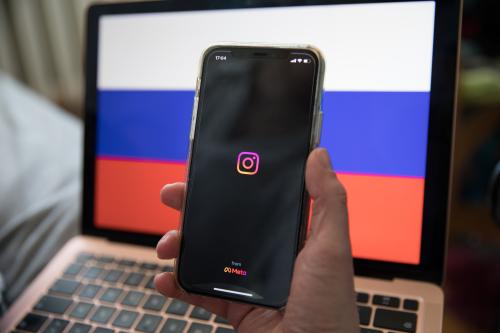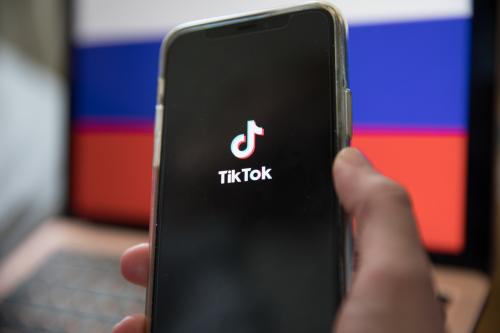Unlike broader Russian narratives that exploit existing grievances of African audiences, most disinformation does not gain the same traction or attention on Twitter.
In part one, we examined tweets from users in or discussing Africa that contained various anti-West rhetoric and “whataboutism” that may or may not contain false information. We found that as the war in Ukraine persisted, anti-Western rhetoric decreased, whereas tweets employing ”whataboutism” increased.
Here we focus on topics that explicitly contain disinformation. The Kremlin continues to target African information spaces with disinformation and propaganda campaigns, spreading claims that seek to delegitimize not only Ukraine but also its allies. It is a guarantee that information “pollution” is present on social media, but how much of the conversation is dominated by these falsehoods?
We can gauge how thick of a fog disinformation casts by identifying how many tweets perpetuate various claims and compare them to those trying to counter the untruths. Users located in Africa or discussing Africa in the context of Russia’s invasion of Ukraine generated over 3.5 million tweets from February 14 through August 14 (note on methodology available at the end of this blog). From these tweets, we isolate those that pertain to specific claims or topics.
The most discussed topic within this collection, generating over 190,000 tweets, pertains to food insecurity and the blockade of Ukrainian ports. Only 10 percent of these tweets blame Western sanctions for food insecurity in Africa—most users lay the blame on Russia. Figure 1 shows the daily percentage of tweets that blame Western sanctions versus those that actively try to correct the claim or blame Russia. Tweets blaming Western sanctions remain far below those stating that Russia is responsible, and never go above 5 percent of the daily generated tweets.
Figure 1. Daily percentage of tweets discussing food insecurity in Africa
Source: Author’s calculations using Twitter data.
The largest surge of tweets perpetuating this claim occurs on June 4, one day following Vladimir Putin’s meeting with African Union Chairperson and President of Senegal Macky Sall. The second surge of tweets blaming sanctions occurred the day Ukraine and Russia signed the grain deal brokered by the United Nations and Turkey. The surge continues to the end of July due to Sergei Lavrov’s tour of Egypt, Ethiopia, Uganda, and the Republic of Congo. Since the grain deal was signed, most of the tweets perpetuating the claim quote Lavrov’s statements during the tour, including that the missile strikes on Odessa ports pose no obstacles for grain shipments.
Most of the tweets generated in these two periods are retweets from Russia Today, pro-Russian anonymous conspiracy accounts, and other pro-Kremlin news websites. These tweets also include links to clips from right-wing media outlets in the U.S. and articles from Russia Today.
In addition, many of the “claim” tweets also allege that the West is trying to purposefully punish Africa for not fully supporting Ukraine. A peculiar aspect of tweets pushing this claim: While these users blame food insecurity on Western sanctions, they also state (sometimes within the same tweet) that Russia has never been more prosperous despite the sanctions.
One topic that draws attention throughout the war pertains to Nazism in Ukraine, producing 72,000 tweets since February. Nearly 77 percent of these tweets perpetuate the claim that Ukrainians are Nazis and/or that Russia is fighting fascism in Ukraine. Tweets bolstering this claim often rely on doctored or old images and videos. As seen in Figure 2, May 17 shows the greatest surge of tweets supporting the claim. Although this coincides with the surrender of Ukrainians defending the Azovstal steel plant, most users actually discussed the redeployment of ground forces in Somalia announced by President Biden the previous day.
Figure 2. Daily percentage of tweets discussing Nazism and fascism in Ukraine
Source: Author’s calculations using Twitter data.
Most of these tweets compare the redeployment to Russia’s war in Ukraine and accuse the U.S. of supporting Ukrainian neo-Nazis. The second largest surge appears on July 16 (continuing to July 24) and concerns a circulating video of alleged neo-Nazis attacking Ukrainian business in 2017. These tweets pepper in claims that NATO is waging a proxy war and that Western media outlets are deliberately ignoring fascism in Ukraine. Finally, the last major wave of tweets occurs on March 12 with a video of an African student in Ukraine being chased into a police station.
In the early stages of the war, most users discussed Nazism in the context of the racism and discrimination African students faced while attempting to flee. Nowadays, the claims are often used within the context of grievances that Africans may have against the U.S. and Europe that may not even be related to Ukraine. This claim is also exploited within broader “whataboutism” sentiments in tweets discussing Western aid or support given to Ukraine throughout the war.
Unlike the majority of disinformation surrounding the war, the most retweeted accounts stating that all Ukrainians are Nazis self-identify as socialist. Many of these accounts have been labeled as “disruptive” by Bot Sentiment for “engaging in malicious tweet activity” that includes sharing misinformation and harassing other accounts.
The only time the number of “checks” exceeded the number of “claims” was on July 31, following the Olenivka prison massacre on July 29. However, these tweets did not discuss the massacre but focused on Russian bombing campaigns in Syria and the neo-Nazis in Russian front lines. Many of the “check” tweets focus on the involvement of the Wagner Group and white supremacist groups in Russia.
Russian diplomats and news sites as well as anonymous conspiracy theory accounts play a crucial role in instigating disinformation on Twitter. Although there is a silver lining that many of these topics do not dominate the conversation, they still contribute to information pollution that is found online. The social media platform has taken some steps to mitigate the spread of disinformation, including no longer promoting accounts linked to Russian state media or labeling government accounts, but that has not prevented these accounts from disseminating falsehoods.
Note on methodology: Over 85 million tweets were compiled using an open-source command line tool known as Twarc, which archives tweets that contain a specific qualifying term—in this case, any tweet containing the word or hashtag “ukraine” “ukrainian” “russia” “russian,” and their variations, from February 14 to March 14, and April 26 to August 14, 2022. Then, a subcollection was made of users who specified they were in Africa using the self-identified “location” in the user’s profile or discussed Africa within the text of a tweet.
The then-smaller collection of 3.5 million tweets was sorted; tweets corresponding to specific disinformation topics were grouped together into “clusters.” Tweets that did not fit into a topic were dropped for the purposes of this analysis. The tweets within each cluster were then sorted into categories of checks and claims.










Commentary
Russian disinformation in Africa: What’s sticking and what’s not
October 17, 2022